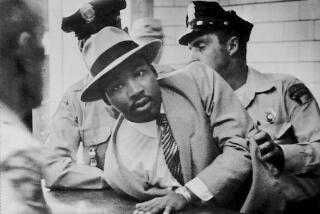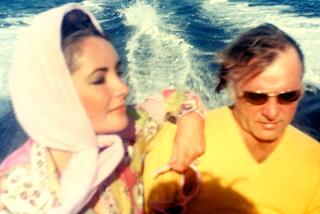Giving Voice to the Voiceless : STUDS TERKEL: A Life in Words.<i> By Tony Parker (Henry Holt: 238 pp., $27.50)</i>
- Share via
An inveterate lover of words, Studs Terkel counts “irony” among his favorites, and no one is more cognizant than the octogenarian oral historian himself of his rather ironic situation. As he muses in “Studs Terkel: A Life in Words,” a new biography from the late Tony Parker, “I’ve become celebrated for celebrating the uncelebrated people of the world, built myself a world reputation for giving voice to the voices of those we never hear.”
However ironic, the winning point that this otherwise eclectic and uneven biography conveys is that the celebration of Terkel is entirely warranted. For the better part of a century, Studs Terkel (nee Louis; the name comes from Studs Lonigan, the eponymous character in the trilogy of novels by hard-boiled Chicago novelist James T. Farrell) has been talking--and more importantly, listening--to people, both as radio host for Chicago’s WFMT and as author of an impressive string of epoch-capturing oral histories, including “Working,” “Hard Times” and the Pulitzer Prize-winning “The Good War,” as well as his latest, “Coming of Age.” In that book, which consists of interviews with people older than 70, Terkel writes of his subjects in an eloquent introduction that “remembrance is the attribute that most distinguishes them. They are, in a sense, living repositories of our past, our history.”
Terkel, 84, is still with us, remembering and listening, although his ability (but not his will) to hear wanes with age. Parker, England’s most prominent oral historian who died recently at 73, shared not only Terkel’s interview format but his ability to listen--one critic called his ears a “national treasure.” As an obituary in the Guardian put it, Parker’s strength was in “mining the richness of forgotten lives, amplifying unheard voices, and always remembering that the truth is in the details.” What distinguishes Parker in his 22 books from Terkel is that his subjects are more than just “forgotten,” but indeed outcasts. Yet he was no less willing to grant them an equal audience, in works such as “The Violence of Our Lives: Interviews With American Murderers,” “The Twisting Lane: Some Sex Offenders” and “The Flying Pan: A Prison and Its Prisoners.”
It was in writing “A Place Called Bird,” which looks at a small town in Kansas, that Parker met “the great Studs Terkel.” In this book, Parker turns the master’s technique around to explore what is revealed to be an enigmatic and somewhat elusive personality. As Terkel tells Parker, his tendency away from self-reflection may be a result--or a cause--of his chosen vocation: “I’ve met thousands of interesting people and I’ve been so caught up with them and fascinated by them and intrigued with them that it’s almost like there’s no room inside me to be all that interested in my own feelings and thoughts.”
Fortunately, there is no shortage of those ready to speak volumes about Terkel, and to his credit Parker has assembled a polyphonous chorus, from community activist Florence Scala, who figures prominently in Terkel’s 1967 “Division Street America,” to publisher Andre Schiffrin, who has shaped Terkel’s literary output ever since he suggested in the mid-1960s that the radio host do an American version of Jan Myrdal’s “Report From a Chinese Village” (and thus “Division Street”).
Like a painting by Seurat, a colorful image of Terkel emerges from a web of minute impressions. We hear repeatedly of Terkel’s “colossal memory,” which enables him to pick up a conversation precisely where it had left off years earlier; we hear of his legendary ineptness with technology and especially his tape recorder, which Terkel suggests might be a strategy for calming his interviewees (“I’m not the Messiah with the microphone”); we hear of his adroitness at eliciting stories from often-recalcitrant subjects, with architect Cedric Price suggesting that Terkel made him feel more articulate than he thought he was. That same ability lends a certain seamlessness and feeling of ease to Terkel’s books, as if he had just turned on the tape recorder in the presence of interesting characters. Not visible in his texts, however, is Terkel’s ability to engage the subject, his wide-ranging knowledge and quick thinking, the intensive editing needed to make the responses flow.
In the book’s most rewarding chapter, Parker interviews Terkel about interviewing. Terkel dismisses the “inquisition” form of questions and answers, saying what’s more essential is the ability to “listen and wait,” to know that “a laugh can be a cry of pain, and a silence can be a shout.” He looks for stories in unusual places, deftly flying under the radar of whoever he’s talking to.
Terkel recounts seeing a woman standing on a street staring into an empty shop window; without hesitating, he asked her what she was looking at. “Dreams,” she said, and he began to record the answer. After he played it back for her, the woman said, “Well, until I heard that, I never knew I felt that way.”
When Terkel moves, seemingly uncomfortably, to the subject of his own life, he is frank. “I know I’m an entertainer, and I like being an entertainer--a clown figure, a Charlie Chaplin, the little guy at odds with the establishment, who doesn’t fit in and doesn’t want to fit in.”
He is surprised as his description of his childhood brings a new assessment of his mother. But ultimately, this book fails to illuminate much of Terkel’s life, sacrificing a more coherent narrative for a scattershot series of Terkel miscellany.
Along with “Talking to Myself,” which is described not as autobiography but as “a memoir of my times,” one could certainly piece together a fair estimation of Terkel’s life.
But even if he does view life as “an accretion of accidents,” it’s asking a little much of the reader to follow that thread without the proper contextual clues biography should provide. We are left wanting, for example, for further details on Terkel’s blacklisting by the House Un-American Activities Committee, which is rendered here only as a difficult time.
The success of Terkel’s books is that he gets the man of “inchoate thought,” as he put it in “Division Street,” thus usually spurning “consciously articulate” voices such as writers--as he says, “my transcribing their attitudes would be nothing more than self-indulgence.”
That concern gets at the heart of this biography’s flaws. The very form that worked so powerfully for Parker and Terkel is here reduced to a pale imitation. With the questioning centered around one man rather than great events or social phenomena, the answers usually seem confined and contrived and thus we learn less than we should about either Terkel or the interviewees.
What is left is a series of mostly well-known people talking about a well-known person and the book offers warm, I-knew-him-when recollections rather than a thorough portrait of his life and a measurement of his formidable contribution in recording the history of 20th century America, as well as his place in it. The definitive Studs Terkel biography awaits.
More to Read
Sign up for our Book Club newsletter
Get the latest news, events and more from the Los Angeles Times Book Club, and help us get L.A. reading and talking.
You may occasionally receive promotional content from the Los Angeles Times.







